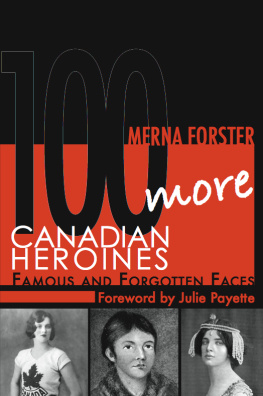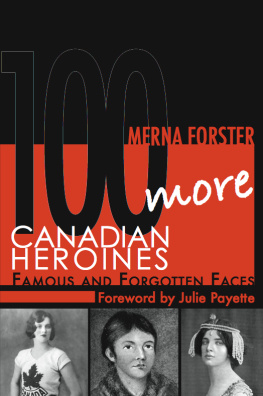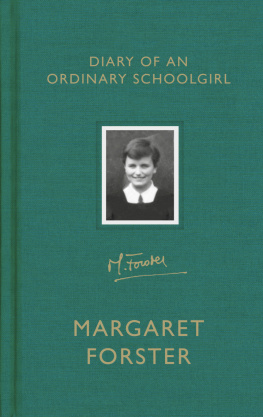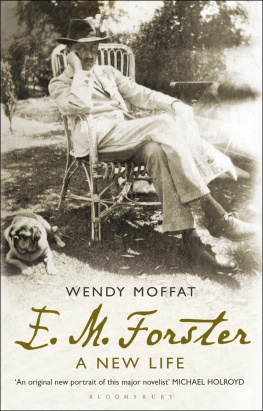Merna Forster - 100 More Canadian Heroines
Here you can read online Merna Forster - 100 More Canadian Heroines full text of the book (entire story) in english for free. Download pdf and epub, get meaning, cover and reviews about this ebook. year: 2011, publisher: Dundurn, genre: Non-fiction. Description of the work, (preface) as well as reviews are available. Best literature library LitArk.com created for fans of good reading and offers a wide selection of genres:
Romance novel
Science fiction
Adventure
Detective
Science
History
Home and family
Prose
Art
Politics
Computer
Non-fiction
Religion
Business
Children
Humor
Choose a favorite category and find really read worthwhile books. Enjoy immersion in the world of imagination, feel the emotions of the characters or learn something new for yourself, make an fascinating discovery.
- Book:100 More Canadian Heroines
- Author:
- Publisher:Dundurn
- Genre:
- Year:2011
- Rating:3 / 5
- Favourites:Add to favourites
- Your mark:
- 60
- 1
- 2
- 3
- 4
- 5
100 More Canadian Heroines: summary, description and annotation
We offer to read an annotation, description, summary or preface (depends on what the author of the book "100 More Canadian Heroines" wrote himself). If you haven't found the necessary information about the book — write in the comments, we will try to find it.
100 More Canadian Heroines — read online for free the complete book (whole text) full work
Below is the text of the book, divided by pages. System saving the place of the last page read, allows you to conveniently read the book "100 More Canadian Heroines" online for free, without having to search again every time where you left off. Put a bookmark, and you can go to the page where you finished reading at any time.
Font size:
Interval:
Bookmark:
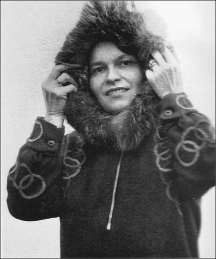
Maud Watt.
Lorene Squire. The Beaver, March 1943.
The Angel of Hudson Bay
18941987
As the beaver in northern Quebec disappeared, the Cree starved. Maud set out on an incredible journey to create a beaver preserve.
Maud Watt was an adventurer, an explorer, and a skillful negotiator said to be as persuasive as the Angel Gabriel. But has she been forgotten?
Born on the Gasp, Maud Maloney was the tenth child in a family of fourteen. Her Irish father worked as a fisherman, carpenter, and boat builder, while her mother, Elizabeth Poirier, managed the hectic, yet happy household. Maud could bake bread as well as hunt hares and ptarmigan and use Morse code. After the family settled at Mingan, Quebec, the young girl attended classes at the nearby convent. Fluent in French and English, she learned Latin and also picked up some Montagnais.
When Maud was twenty-one, she married a young Scotsman named James Watt, a clerk for the Hudsons Bay Company (HBC). Hed been offered a job as subdistrict manager of Fort Chimo on Ungava Bay. The newlyweds were soon Arctic-bound on the icebreaker Nascopie . Their honeymoon began a lifetime of adventure in the North.
Eager to visit as much of the country as possible, Maud charmed the captain into allowing them to stay aboard for the planned circuit to Baffin Island and Hudson Bay. During the trip, she scampered over rocky shores, picking Arctic flowers and meeting the Inuit. The fun-living Maud also played poker on the ship, noting that she lost and won cars, pianos, and jewels enough to cover the Queen of Sheba.
From her first days in Fort Chimo, Maud welcomed the Natives into her home and treated them respectfully, unlike many of the HBC employees and their wives. The Watts were caring and compassionate, genuinely concerned about the welfare of those who traded with the company. When the supply ship didnt appear for three years, the Watts made a gruelling 800-mile journey from Fort Chimo to the St. Lawrence for help.
When the Watts arrived at Sept-les months later, they found the Quebec-bound steamer already full. A gentleman kindly offered them his stateroom. The chance meeting would prove helpful, as Mauds admirer was the Honourable L.A. Taschereau, future premier of Quebec.
In 1919, James was reassigned to Rupert House on James Bay. It had been one of the most productive beaver-trapping areas in the world, but was receiving only a few thousand beaver skins the year the Watts arrived. The numbers plummeted each year, and Rupert House was operating at a loss. With few beaver available, the Cree were suffering. It was one of their major food sources and they needed to trade the furs to survive.
In 192829, Rupert House received only four beaver skins. Many Cree were starving. James Watt suggested the creation of a beaver farm to provide steady production of beavers, but the HBC ignored his desperate pleas. When two men told James theyd found an occupied beaver lodge, he used his own money to buy the live beaver so they could live in the wilderness. He also convinced the local Cree that leaving the beaver to reproduce would eventually result in a sustainable resource. James continued paying Natives to guard the beavers, but his credit was running out and threat of poaching grew. By the third year, there were more than 200 beaver.
Though it was mid-winter, the Watts decided they had to act immediately. They decided to ask the Quebec government to set aside some of its territory as a beaver preserve. The government wasnt likely to be receptive, and James would probably be fired for abandoning his post. Plus, he couldnt speak French. Maud decided to travel to Quebec City immediately to plead on behalf of the Natives of northern Quebec.
It was sixty below zero when Maud set out on dogsled, with two skilled men and her children (aged three to six) bundled up in bearskins. After an arduous journey by sled, foot, and finally train, the group arrived in Quebec about a month after departing. Maud met with the deputy minister of the provincial fisheries department, Louis A. Richard; she calmly asked for a large reserve, offering a token payment of $10. After subsequent meetings and considerable negotiation, Premier Taschereau and his cabinet approved her audacious request.
Maud returned with a lease from the Province of Quebec for 7,200 square miles of territory to be used as a beaver reserve. She served as proprietor of the Rupert House Preserve, but the Watts couldnt finance the venture indefinitely. Eventually, the Hudsons Bay Company took over the lease. By 1940 there were over 4,000 beavers, and licensed hunters could trap within the preserve, according to a quota system. The Rupert House Preserve became a model for other beaver preserves across Canada.
When James died of pneumonia in 1944, Maud lost both the love of her life and her home. A few days after his death she climbed into a float plane to fly south, but Mauds heart stayed in Rupert House. She later returned to set up a bakery. She also built the J.S.C. Watt Memorial Community Hall and adopted several Cree children.
During Mauds lifetime, she received a number of honours in recognition of her devotion to improving the lives of the First Nations of northern Quebec. In 1952, the Province of Quebec appointed her official warden of Rupert House, providing her with authority, a badge, and a modern two-storey house. She was the first female game warden in the province. The Beaver Club in Montreal, the historic association of wealthy fur traders, presented her with a golden trophy. The well-dressed and elegant Maud, speaking in classic French, charmed the members with her gracious acceptance speech.
Maud was awarded the Order of Canada in 1971. She died in Ottawa in 1987 but was buried in Rupert House near her beloved James, in the land that she called home. In March 2009, Radio-Canada broadcast a program about Maud Watt in a series about remarkable people who have been forgotten.

Maud Watt with sleigh.
The Beaver, March 1943.
Quote:
here I am standing on a hilltop with a jewelled world at my feet and healthy and happy with an appetite no millionaire could buy and not a worry in the world.
Maud Watt describing her view near Ungava Bay.

Mother Esther Marie-Joseph de lEnfant-Jsus, circa 1763.
From Captive to Mother Superior
16961780
She was once a devout Puritan girl. But her dedication to Catholicism helped save the Ursulines after the fall of New France.
In the summer of 1703, Esther Wheelwright was seven years old, a happy child on the American frontier. The daughter of prominent pioneers Colonel John Wheelwright and Mary Snell, she was born and raised in Wells, Massachusetts. The Wheelwrights were influential Puritans; Colonel Wheelwright served as a judge, town clerk, and councillor.
On August 21, 1703, hundreds of Abenaki warriors and French forces raided the community of Wells, torching buildings, killing twenty-two, and kidnapping seven, including Esther. The terrified child joined sixty-eight captives from other nearby communities. The raiding party forced the prisoners to march north on an incredible 200-mile journey through forests and swamps. After about a week, Esther and the other surviving captives arrived in the Abenaki village of Norridgewock, near the Kennebec and Androscoggin Rivers, in New France.
Font size:
Interval:
Bookmark:
Similar books «100 More Canadian Heroines»
Look at similar books to 100 More Canadian Heroines. We have selected literature similar in name and meaning in the hope of providing readers with more options to find new, interesting, not yet read works.
Discussion, reviews of the book 100 More Canadian Heroines and just readers' own opinions. Leave your comments, write what you think about the work, its meaning or the main characters. Specify what exactly you liked and what you didn't like, and why you think so.

